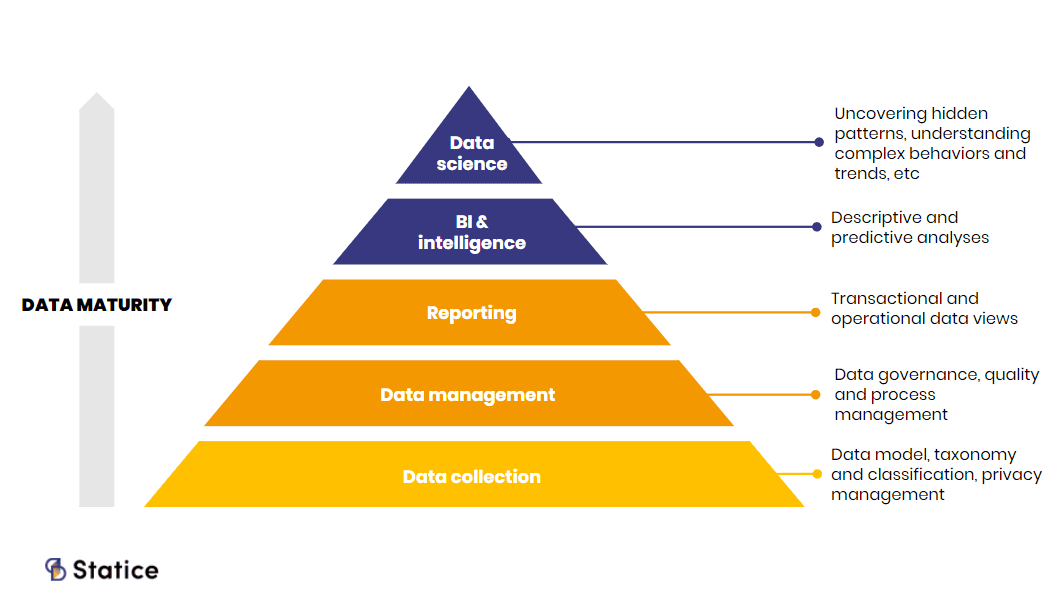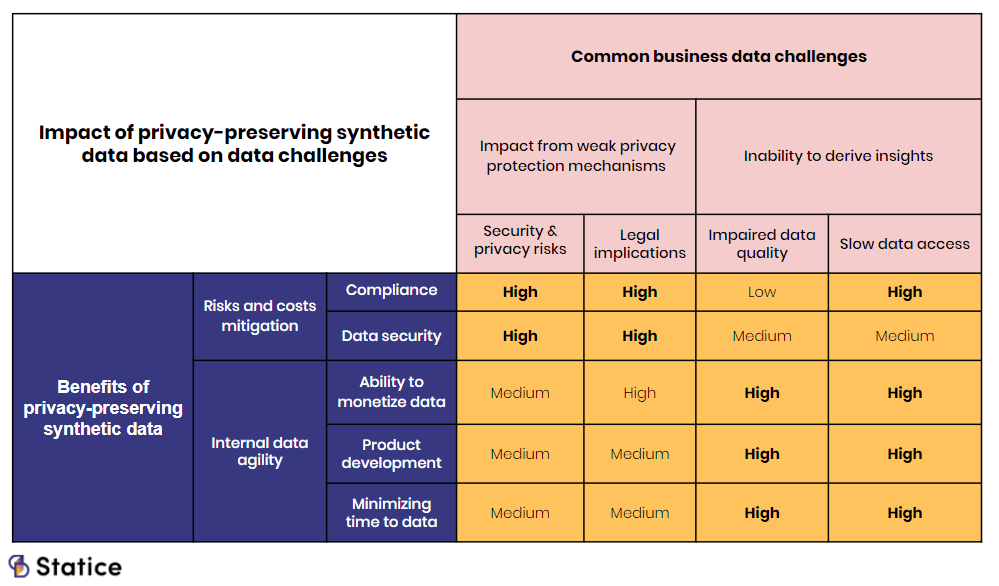If you team is evaluating privacy-preserving synthetic data, three factors will usually come into consideration:
- Does synthetic data solve my problem?
- Does the technology fit my requirements?
- What’s the Return on Investment (ROI) of implementing privacy-preserving synthetic data?
This post focuses on the last factor: the value of adding synthetic data generation capabilities to your team’s toolbox.
The cost of data inertia and insufficient privacy-preservation mechanisms
Data is the key to gaining competitive advantages. Forrester reported insights-driven businesses growing at an average of more t…. There is no digital transformation without data. It is critical to the operations of data-driven companies. However, many obstacles are preventing businesses from achieving the transition to being data-driven, costing them money and business opportunities.
While the costs vary from one enterprise to another, we usually see two cost types. The first one arises from the inability to leverage data and the second one from the compliance, brand, and social risks of using weak privacy-preservation mechanisms. The inability to derive insights or drive innovation from data represents a high cost for businesses. Data’s value comes from our ability to transform it into insights to drive decisions and strategy, predict trends and revenue opportunities, build new products, and solve problems.

In a company, data starts bringing business value as data teams derive insights from it.
Reproduction of Jay Zaidi data value pyramid
The cost of inertia
The inability to derive insights can be due to several factors. In some cases, the data is too sensitive to be moved, processed, or used. Data teams are then unable to access it. In these cases, you are passing on 100% of the value you could be generating. Depending on the business priorities, the current state of data access and the target stage, data inertia can cost businesses a large chunk of revenues.
In cases where it’s possible to access parts of it, the data has been stripped of so much information to protect sensitive information that it is of no use for analysis. In these scenarios, you can generate a smaller value but never reach the data’s full potential.
For Ted Friedman, vice president and distinguished analyst at Gartner, “as organizations accelerate their digital business efforts, poor data quality is a major contributor to a crisis in information trust and business value, negatively impacting financial performance.”
In other cases, siloed architectures and cumbersome governance processes obstruct data sharing. Requesting data is a slow process, when possible at all, that impacts timely decision making, innovation, and analysis. In these scenarios, data teams’ time and resources might outweigh the value derived from the data.
The cost of weak privacy protection mechanisms
Other costs arise from the impact weak privacy protection mechanisms have on companies. To protect sensitive data and comply with personal data protection laws, many choose privacy mechanisms. However, as we recently explained, most of the traditional privacy mechanisms can not guarantee total anonymity. These technologies are putting data and businesses at risk. And these risks are associated with costs.
Companies using data masking or pseudonymization approaches expose the data to leakage and reidentification. Whether it concerns customer data or sensitive business information, the cost of a breach isn’t trivial. Researchers at IBM reported that the average cost of a data breach to a business could climb up to $3.92 million.
In addition to security risks, European enterprises are evolving within strictly regulated environments. The General Data Protection Regulation (GDPR) adds up to national and industry-specific regulations. The costs of non-compliance keep on rising, as they include not only fines settlements but also business disruption, productivity, and revenue loss. In a 2018 report, research firm Ponemon Institute and security company GlobalScape published that the annual cost of non-compliance to businesses now runs an average of $14.8 million.
Privacy-preserving synthetic data offers an alternative to using sensitive data. It allows companies to overcome their inability to derive insights from sensitive data and the risks associated with traditional privacy protection mechanisms.
Where synthetic data brings value
Companies that decide on implementing synthetic data as an anonymization method can expect a return on investment along two axes. The first one is the easiest to quantify. It is a set of new revenues or reduced costs directly derived from their newly-gained ability to leverage data. The second axis is harder to quantify but equally essential. It encompasses the risks and costs mitigation associated with insufficient data protection.

Where does privacy-preserving synthetic data adds the most value based on data challenges
The ability to derive insight
Using synthetic data to fuel data analysis represents a critical opportunity for companies. Theoretically, this approach offers companies an unlimited data pool to power any data-driven analytics use-case and unlock the ability to derive insights from sensitive data. It grants companies the ability to go from “I can’t do anything with my data” to “I have a compliant, safe and usable data source“.
This data source offers a significant analytics valuethanks to its non-sensitive nature. It holds the same statistical properties as the original data, without any risks associated with privacy violation. Correctly generated synthetic data will power any applications intended for the original data, with only minimal performance losses.
The fact that it offers a higher value is true whether we measure the use of privacy-preserving synthetic data against the original data itself or other protection mechanisms. When compared with using sensitive data, privacy-preserving synthetic data will always win value-wise. The information is too sensitive to be used in the first place. Suppose we measure the value against other protection mechanisms. In that case, privacy-preserving synthetic data offers a higher value because it generates a more accurate, private, and easy-to-handle analytical resource. In most cases, alternative options induce a more extensive loss of utility of the resulting data or force compromises in privacy protection or data agility.
With privacy-preserving synthetic data, companies can drive internal data agility, saving costs bycutting their time-to-data. Because privacy-preserving synthetic data is private by design, companies reduce their teams’ time on internal governance and clearance processes when it comes to data sharing.
Another direct ROI is the possibility of creating new revenue streamsfrom data monetization or product development. You won’t be able to monetize individual personal data without consent and several layers of privacy protection. But what you can derive value from is the underlying statistical patterns, which are of course preserved in the synthetic data. In this regard, privacy-preserving synthetic data represents a high-potential opportunity for companies storing large volumes of personal data. According to Accenture, 40% of financial institutions worldwide are now investing in data i…. Being able to share customer or market data without privacy concerns is an essential building block to being able to capitalize on this trend.
Risk mitigation
By nature, privacy-preserving synthetic data is completely anonymous and has no one-to-one relationship with the original data. Companies using this technology can generate data that falls out of the scope of personal data regulations, limiting non-compliance risks. They also get stronger privacy guarantees than traditional masking and de-identification methods, mitigating the potential damages if breached.
A recent study conducted by the Ponemon Institute estimated that customers’ PII was the most expensive data to lose in a breach, estimated at a recovery cost of about $150 per record. That cost rose to $175 if a malicious attack caused the breach. While working with synthetic data doesn’t directly prevent hack attempts on personal data, it’s a way of limiting unnecessary exposure of sensitive data.
Additionally, companies using privacy-preserving synthetic data can rule out any legal violation of privacy laws, at least for the associated use-cases. Processing data that underwent pseudonymization is, by contrast, more heavily regulated and can be non-compliant with privacy regulations.
The gain of customer trust also represents a significant value for companies, although it’s hard to quantify. In a world plagued by data breaches and scandals, customers are less inclined to trust businesses with their money and confidential information.
The EU Agency’s Fundamental Rights survey reported that “41% [of Europeans] do not want to share any personal data with private companies, almost double the number compared to public bodies”. And forrester’s analysis showed that better privacy practices directly impact customers’ purchases and willingness to provide personal data.
There are, of course, costs associated with implementing new technology. However, solutions like Statice’s solution are designed to be as straightforward as possible regarding integration and usage. The costs and benefits are also highly tied to multiple factors specific to each industry and company. From our experience, privacy-preserving synthetic data remains an opportunity for all the enterprises faced with data inertia and data privacy concerns.
